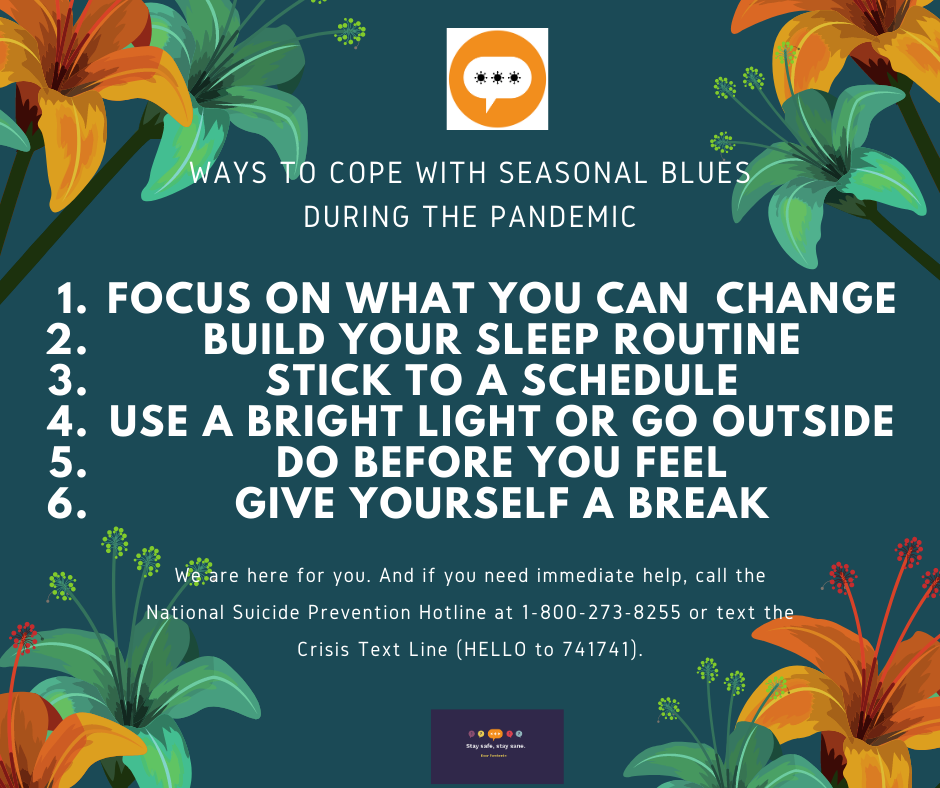A: Not necessarily! There are things you can do to ward off the blues.
TL; DR: Focus on variables you can change: sleeping, scheduling, using a bright light, planning activities, and allowing yourself breaks.
The Long Version: We know that the pandemic has worsened mental health symptoms (primarily anxiety and depressive symptoms), especially for young people, people of color, people from low income backgrounds, people who know someone who has had or succumbed to COVID-19, and people with pre-existing mental health issues (https://bit.ly/3oE8T1Q ). And it is also known that some people experience worsening mood in the fall to winter months. For those with functionally impairing symptoms that limit daily activities, this is referred to as seasonal affective disorder (SAD), a type of depression that reoccurs every year during the fall/winter months for at least two consecutive years.
And while less than 5% of individuals typically experience severe symptoms, up to 15% can experience more mild symptoms in a given year (https://bit.ly/2W0FjYm). This is especially concerning in the context of the current pandemic and restriction of normal coping mechanisms such as getting outside, gathering with friends, seeing family, and exercising. While people with SAD usually experience some symptom relief in the summer, this past summer may not have offered that reprieve due to pandemic related stressors. For these reasons, there is concern that this fall may be a difficult one for both people with new mental health symptoms related to pandemic stressors as well as people with previous experiences of SAD.
But, there ARE things we can all do to help protect ourselves from the blues, whether pandemic blues or SAD itself.
*Focus on what you can change: A nerdy girl favorite. We can’t change what others do, but as we have talked about before, we can focus on what we can do to reduce our own anxiety).
*Get enough sleep and create a routine: Be consistent with wake up time and bedtime (Target 7-8 hours per night), avoid screens an hour before bedtime, and create a wind down routine in the evening.
*Stay on a schedule: Stick to a schedule, even if you aren’t leaving the house. Shower and get dressed every day, follow regular meal patterns, and create separation between working and resting time.
*Use a bright light: Use a commercial light box, happy light, or SAD light. Boxes with at least 10,000 lux of light can improve seasonal changes in mood. Sit to the side of it for 20-30 minutes in the morning. Some also offer alarm clock options to simulate dawn in the morning. The important thing is to be consistent. And you can still get out for a walk for at least 30 minutes a day. Experts suggest that the morning is best, either for a walk or when using a box light.
*Fight the wish to do nothing: Many experts recommend this technique called behavioral activation. Essentially, doing comes before feeling. In a very basic sense, an individual does more positive things and mood improves.
*Give yourself a good break: Take a break as you need it and accept that it is OK to need a break. We are in this for a long period of time and we all (including us Nerdy Girls) need a break sometimes to watch TV, clean out a closet, or simply “be” sometimes!
These represent just a few strategies that are evidence based. However, if these strategies don’t seem to work, please do follow up for additional help through your primary care clinician. If you need additional resources, Mental Health America (MHA) offers a great way to search for resources. And if you are in need of immediate assistance, please call the National Suicide Prevention Hotline at 1-800-273-8255 or text the Crisis Text Line (HELLO to 741741).
Stay Safe. Stay Sane. And Stay Hopeful!
With love,
The Nerdy Girls



